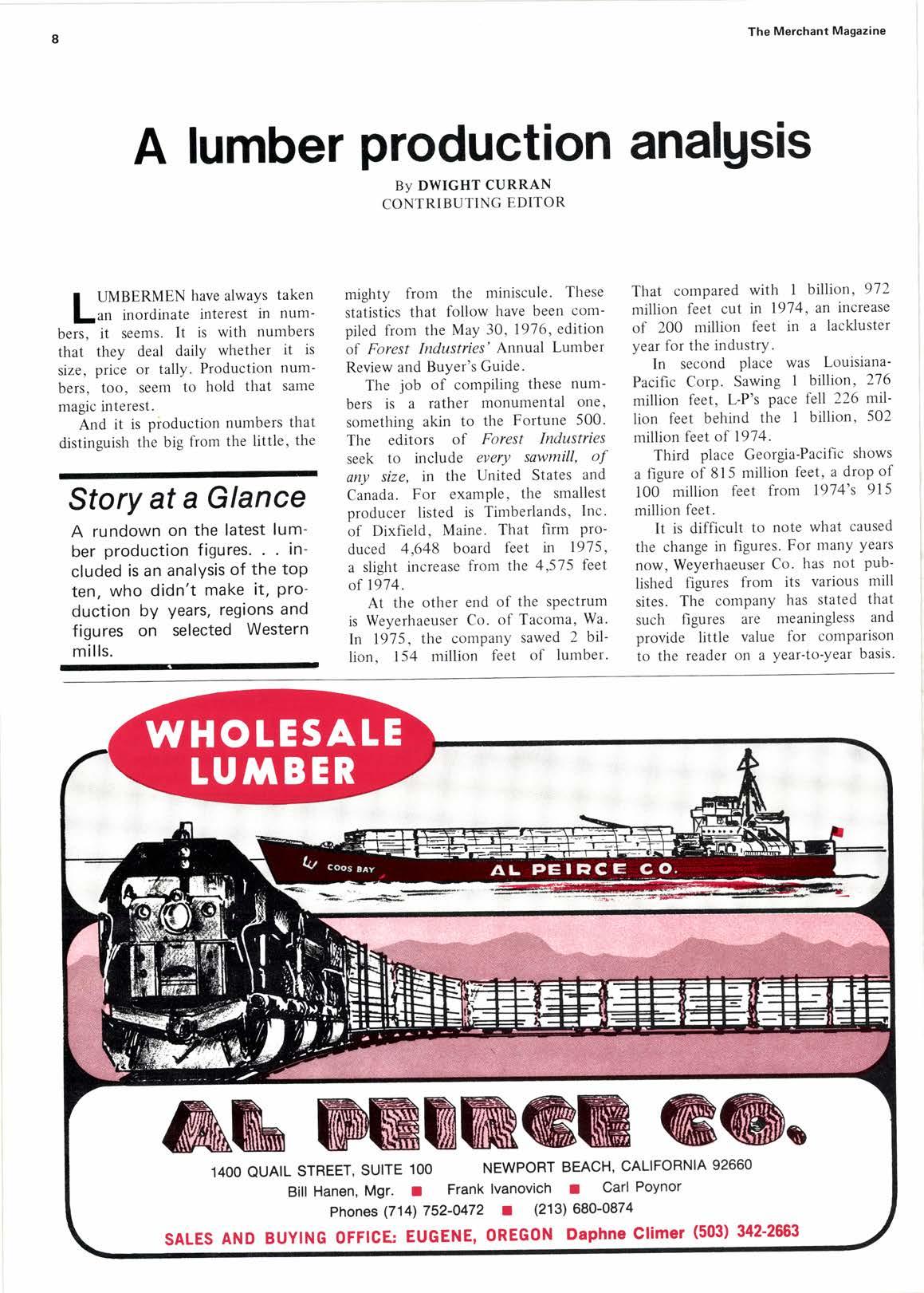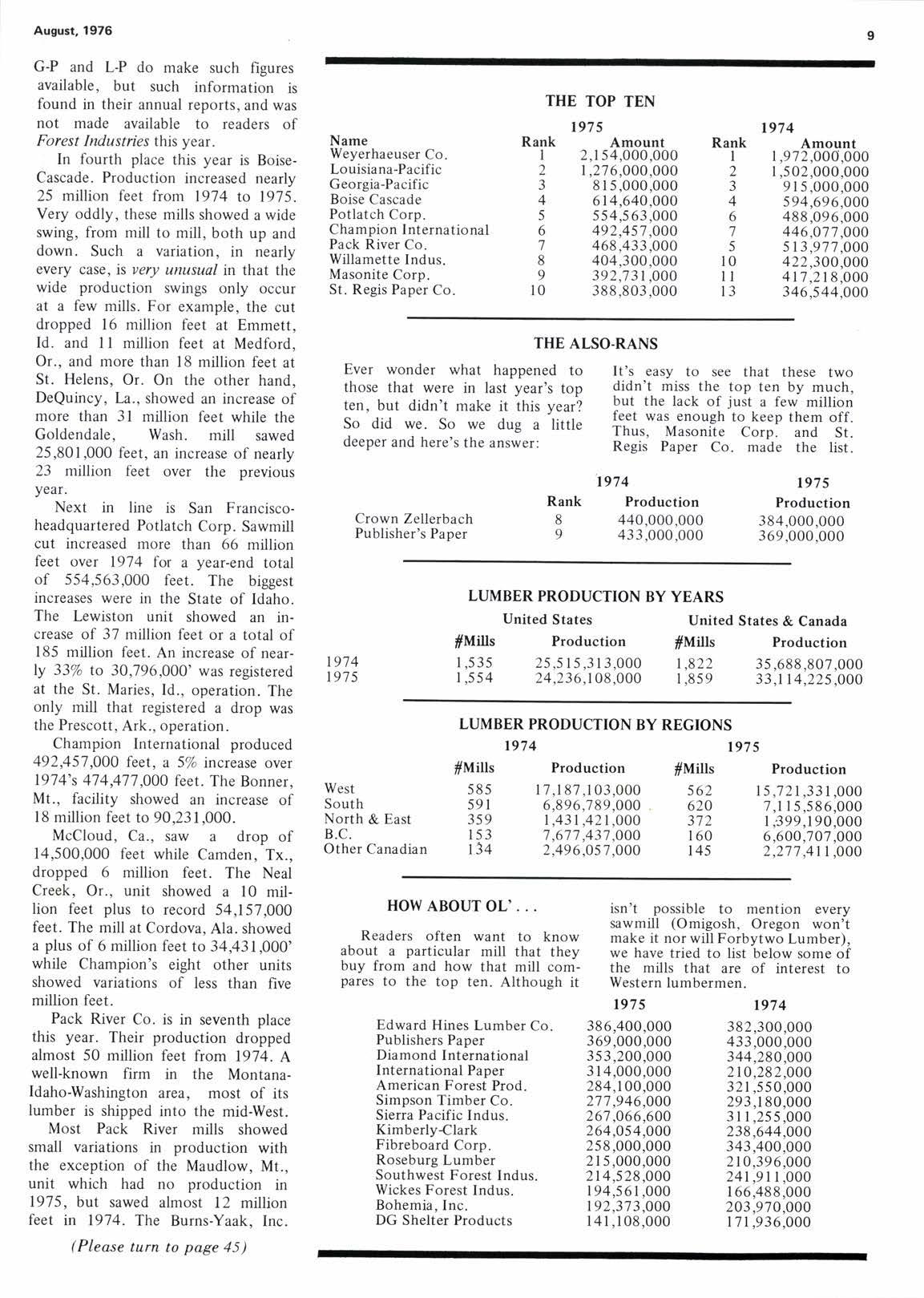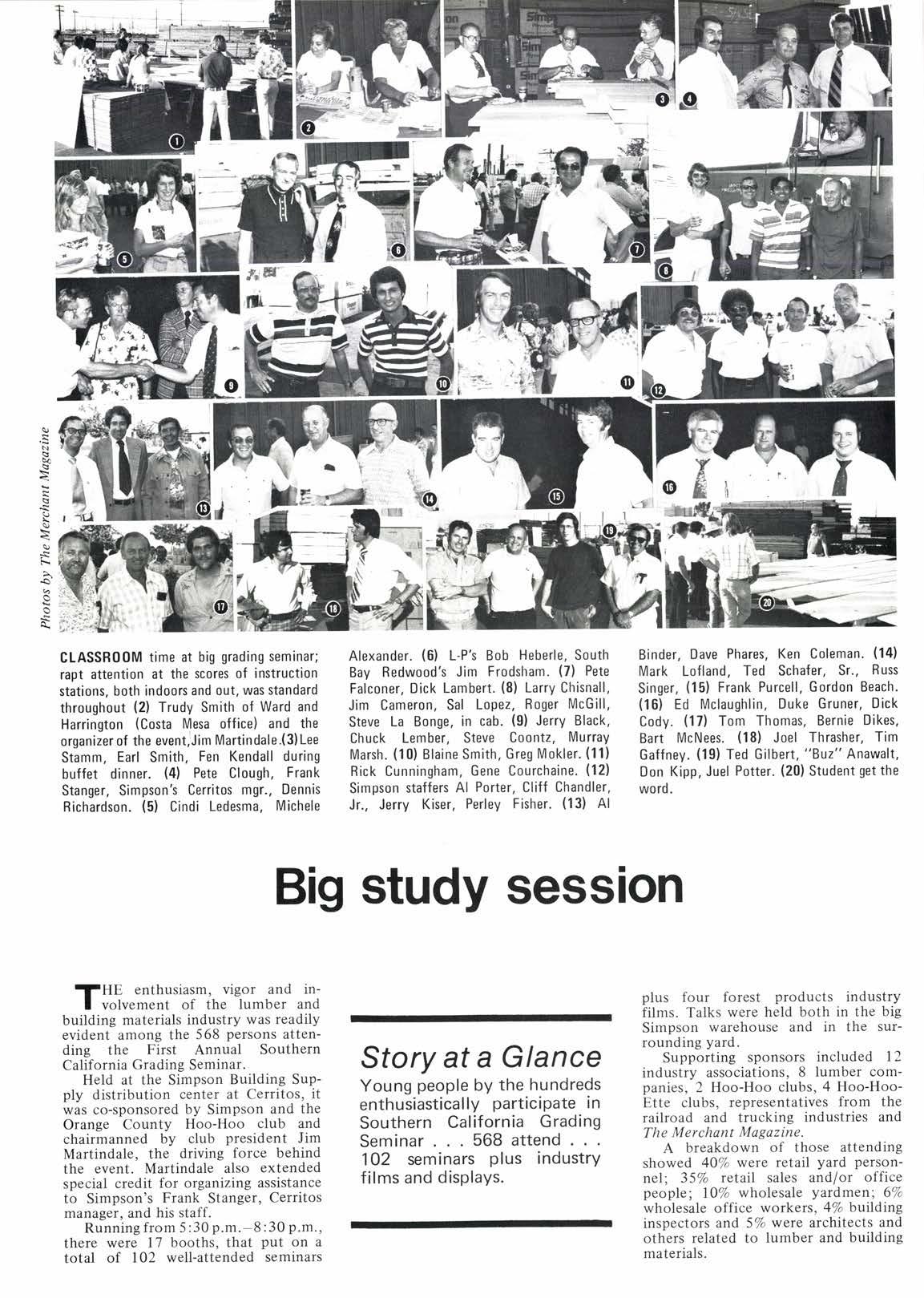
4 minute read
A lumber production analusis
By DWIGHT CURRAN CONTRIBUTING EDITOR
IUMBERMEN have alwaYs taken l-an inordinate interest in numbers, it seems. It is with numbers that they deal dailY whether it is size, price or tally. Production numbers, too, seem to hold that same magic interest.
And it is production numbers that distinguish the big from the little, the
Story at a Glance
A rundown on the latest lumber production figures. included is an analYsis of the toP ten, who didn't make it, Production by years, regions and f igures on selected Western mills.
mighty from the miniscule. These statistics that follow have been compiled from the May 30,1916, edition of Forest Industrtes'Annual Lumber Review and Buyer's Guide.
The job of compiling these numbers isa rather monumental one, something akin to the Fortune 500' The editors of Forest Industries seek to include every sawmill, of any size, in the United States and Canada. For example, the smallest oroducer listed is Timberlands, Inc. bf li*t.ld, Maine. That firm produced 4,648 board feet in 1975, a slight increase from the 4,575 feet of 1974.
At the other end of the sPectrum is Weyerhaeuser Co. of Tacoma, Wa. ln 1915, the companY sawed 2 billion, 154 million feet of lumber.
That compared with I billion, 972 million feet cut in 7974, an increase of 200 million feet in a lackluster year for the industrY.
In second place was LouisianaPacific Corp. Sawing I billion, 276 million feet, L-P's pace fell 226 mll' lion feet behind the I billion, 502 million feet of 1974.
Third place Georgia-Pacific shows a figure of 815 million feet, a droP of 100 million feet from 1974's 915 million feet.
It is difficult to note what caused the change in figures. For many years now, Weyerhaeuser Co. has not Published figures from its various mill sites. The company has stated that such figures are meaningless and provide little value for comparison to the reader on a year-to-year basis.
G-P and L-P do make such figures available, but such information is found in their annual reports, and was not made available to readers of Forest Industies this year.
In fourth place this year is BoiseCascade. Production increased nearly 25 million feet from 1974 to 1975. Very oddly, these mills showed a wide swing, from mill to mill, both up and down. Such a variation, in nearly every case, is very unusual in that the wide production swings only occur at a few mills. For example, the cut dropped 16 million feet at Emmett, Id. and I I million feet at Medford, Or., and more than 18 million feet at St. Helens, Or. On the other hand. DeQuincy, [a., showed an increase of more than 3l million feet while the Goldendale, Wash. mill sawed 25,801,000 feet, an increase of nearly 23 million feet over the previous year.
Next in line is San Franciscoheadquartered Potlatch Corp. Sawmill cut increased more than 66 million feet over 1974 for a year-end total of 554,563,000 feet. The biggest increases were in the State of ldaho. The Lewiston unit showed an increase of 37 million feet or a total of 185 million feet. An increase of nearly 33% to 30,796,000' was registered at the St. Maries, Id., operation. The only mill that registered a drop was the Prescott, Ark., operation.

Champion International produced 492,457,000 feet, a 5% increase over 1974's 414,477,000 feet. The Bonner, Mt., facility showed an increase of 18 million feet to 90,231,000.
McCloud, Ca., saw a drop of 14,500,000 feet while Camden, Tx., dropped 6 million feet. The Neal Creek, Or., unit showed a l0 million feet plus to record 54,157,000 feet. The mill at Cordova, Ala. showed a plus of 6 million feet to 34,431,OOO' while Champion's eight other units showed variations of less than five million feet.
Pack River Co. is in seventh place this year. Their production dropped almost 50 million feet from 1974. A well-known firm in the MontanaIdaho-Washington area, most of its lumber is shipped into the mid-West.
Most Pack River mills showed small variations in production with the exception of the Maudlow, Mt., unit which had no production in 1975, but sawed almost 12 million feet in 1974. The Burns-Yaak. Inc.
(Please turn to page 45)
THE ALSO.RANS
Ever wonder what happened to those that were in last year's top ten, but didn't make it this year? So did we. So we dug a little deeper and here's the answer:
It's easy to see that these two didn't miss the top ten by much, but the lack of just a few million feet was enough to keep them off. Thus, Masonite and St. Regis Paper Co. made the list.
Lumber Production By Years
Lumber Production By Regions
HOW ABOUT OL'.
Readers often want to know about a particular mill that they buy from and how that mill compares to the top ten. Although it isn't possible to mention every sawmill (Omigosh, Oregon won't make it nor will Forbytwo Lumber), we have tried to list below some of the mills that are of interest to Western lumbermen.
CLASSR00M time at big grading seminar; rapt attention at the scores of instruction stations, both indoors and out, was standard throughout (2) Trudy Smith of Ward and Harrington (Costa Mesa office) and the organizer of the event.Jim Martindale.(3)Lee Stamm, Earl Smith, Fen Kendall during buffet dinner. (4) Pete Clough, Frank Stanger, Simpson's Cerritos mgr., Dennis Bichardson. (51 Cindi Ledesma, Michele
Alexander. (61 L-P's Bob Heberle, South Bay Redwood's Jim Frodsham. (7) Pete Falconer, Dick Lambert. (8) Larry Chisnall, Jim Cameron, Sal Lopez, Roger McGill, Steve La Bonge, in cab. (9) Jerry Black, Chuck Lember, Steve Coontz, Murray Marsh. (10) Blaine Smith, Greg Mokler. (11) Rick Cunningham, Gene Courchaine. (12) Simpson staffers Al Porter, Cliff Chandler, Jr., Jerry Kiser, Perley Fisher. (13) Al
Binder, Dave Phares, Ken Coleman. (14) Mark Lofland, Ted Schafer, Sr., Russ Singer, (151 Frank Purcell, Gordon Beach. (16) Ed Mclaughlin, Duke Gruner, Dick Cody. (17) Tom Thomas, Bernie Dikes, Bart McNees. (18) Joel Thrasher, Tim Gaffney. (19) Ted Gilbert, "Buz" Anawalt, Don Kipp, Juel Potter. (20) Student get the word.











